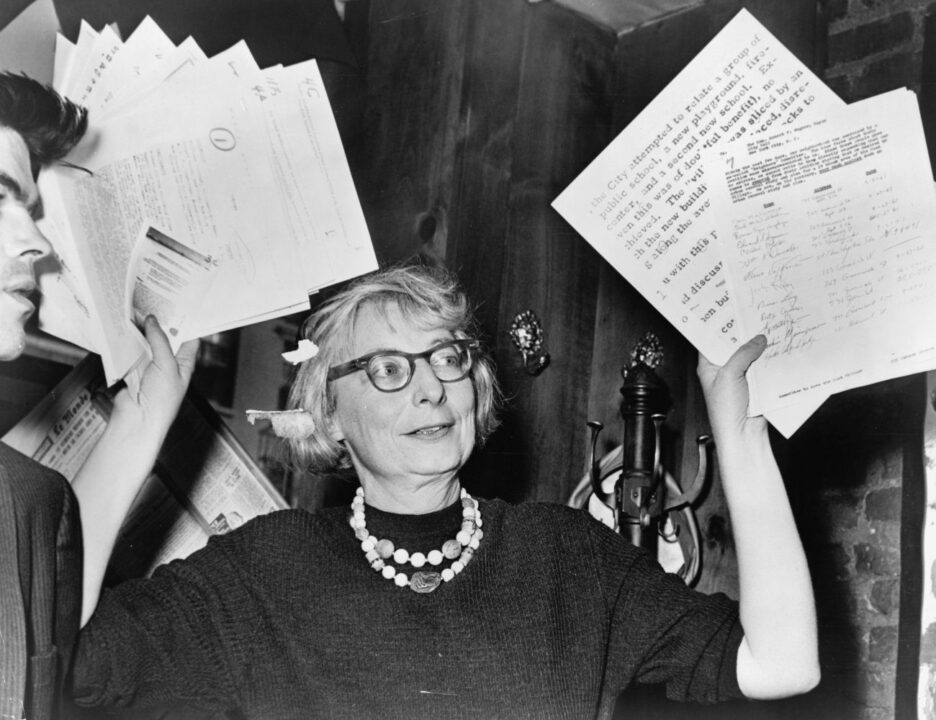As I write all this, I realize I’m hardly even reviewing the movie, but sharing some of the insight and revelation I’ve gained by watching it.
A primary purpose of nonfiction filmmaking is rooted in education and a deeper understanding of a topic. So while film aficionados are often looking for boundary-pushing methods and devices to tell these stories, there is something inherently important about the simple matter of using documentary as a tool of education. And a documentary like Citizen Jane: Battle for the City is an education that we all could stand to gain from.
The ultimate shake-up experienced by watching Citizen Jane is that the design of the cities we inhabit does not have to be this way. Many cities are constructed and planned so poorly for the masses, or done in a way to make a handful of people wealthy. Two examples I accept as “must-haves” for cities are: busy/wide avenues for cars and massive high rises. These are both concepts designed to inflate the wealth of the auto and construction industries and result in a massive degradation of public spaces and the essential human interaction that comes from it. And not every city depends on either to grow large and create inhabitable spaces.
This historical doc hones in on a period post-WWII when modernism was all the rage and a handful of elites were attempting to draw the city of the future, which turned out to be a design that looked nice from the top down but had no bearing on what the people inhabiting it would actually find useful. In opposition, an individual named Jane Jacobs called out how disastrous these ideas were. Jane Jacobs was a person of the people: she lived in a city, she took the time to see how it operated. Her famous book The Death and Life of the Great American Cities was a carefully researched look at how cities operate as living organisms and ecosystems that grew character and functionality from the bottom-up, rather than some master plan. These are concepts I have never fully understood and had accepted the way cities are designed as a standard when in fact they are counter to these arguments. Alas, my sister, who is a published graduate student in geography studies, undoubtedly has been aware of Jane Jacobs’ philosophies for years at this point. Seeing everything laid out here is an education I had yet to experience, and I imagine is true of most city dwellers.
Her famous book The Death and Life of the Great American Cities was a carefully researched look at how cities operate as living organisms and ecosystems that grew character and functionality from the bottom-up, rather than some master plan.
The film follows a few of the battles Jane waged against urban tycoon Robert Moses, who attempted to eradicate affordable housing and public community spaces in favor of massive high-rise projects and vast highways. Today, cities (especially Los Angeles) are so car-dependent it’s hard for us to imagine a design where they aren’t needed. The most well-functioning cities are not. Through a series of expert interviews and archival images, we get a sense of the formation of many cities that were designed to be modern, yet most of which ended up being failures and becoming dilapidated. It’s inspiring to see what people can do to oppose terrible legislation decisions, and I only wish that I personally knew how to stand up as an activist in the tangible way Jane Jacobs did. Despite seeing some of her successes, this film is by no means a how-to.
As I write all this, I realize I’m hardly even reviewing the movie, but sharing some of the insight and revelation I’ve gained by watching it. There is much to be learned from watching this film and it will leave a profound look at how cities function and operate, something we all can benefit from. In my hometown of Denver, Colorado, mayor Michael Hancock has been notorious for approving so-called ‘modern’ high rises. Like Robert Moses in this film, there is much money to be made. And yet after seeing this movie, there is evidence that suggests how detrimental these are toward the community and the vitality that makes a city feel inhabited. It’s a straightforward think piece, but one that feels extremely beneficial to have walked away from, and for that alone, I implore all fellow urbanites to check out the education of Citizen Jane.
‘Citizen Jane: Battle for the City’ is not rated. 92 minutes. Now playing at the Nuart Theatre.
H. Nelson Tracey
Nelson is a film director and editor from Denver based in Los Angeles. In addition to writing for Cinemacy, he has worked on multiple high profile documentaries and curates the YouTube channel "Hint of Film." You can check out more of his work at his website, hnelsontracey.com


